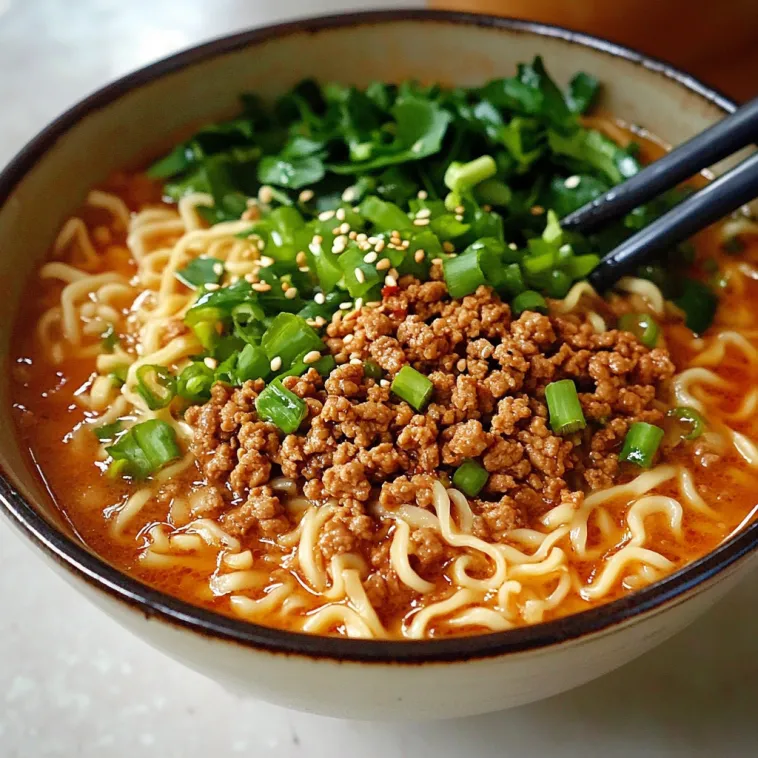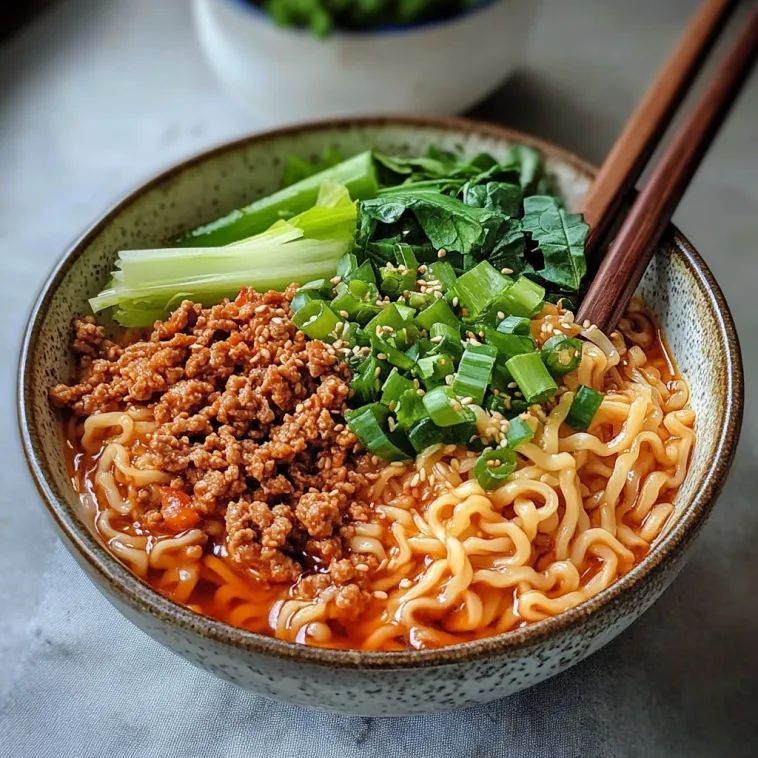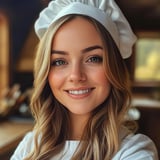 Bookmark
Bookmark
This hearty vegan tantanmen ramen has become my go-to comfort meal on cold, rainy evenings. The rich, creamy broth combined with flavorful tofu "meat" creates a deeply satisfying bowl that rivals any restaurant version.
I first made this recipe during a particularly dreary winter weekend when I was craving something warming but didn't want to leave the house. After one bite, my partner declared it better than our favorite ramen shop's version, and it's been in our regular rotation ever since.
Ingredients
- Extra firm tofu: Forms the base of our vegan meat substitute offering protein and a satisfying texture
- Szechuan peppercorns: Provide that authentic numbing sensation essential for true tantanmen flavor
- Asian sesame paste or tahini: Creates richness and depth in the broth though Chinese sesame paste will give even more authentic results
- Soy milk: Adds creaminess without dairy making the broth silky and indulgent
- Japanese chili oil (layu): Brings essential heat and complexity that regular chili oil cannot match
- Bok choy: Adds freshness and nutritional balance to the rich bowl
- Ramen noodles: Provide the perfect chewy texture to complement the creamy broth
Step-by-Step Instructions
- Prepare the Tofu "Meat":
- Drain your tofu thoroughly by wrapping in paper towels and pressing under a heavy plate for at least 10 minutes. This removes excess moisture and allows for better browning. Crumble with your fingers until it resembles ground meat texture. Sauté with garlic and ginger until deeply browned and crispy around the edges—about 15 minutes total. The dark soy sauce addition gives that meaty color while the spices infuse throughout.
- Cook the Noodles:
- Bring a large pot of water to a rolling boil then lower heat to medium. Add your noodles and cook until they're still quite chewy, about 1-2 minutes less than package directions. This undercooking is crucial as they'll continue softening in the hot broth later. Immediately rinse under cold water to stop the cooking process and prevent sticking.
- Create the Flavor Base:
- Sauté green onions with Szechuan peppercorns in sesame oil until fragrant and softened. This aromatic base forms the foundation of your broth's complex flavor. The peppercorns should be lightly toasted to release their essential oils but not burned which would create bitterness.
- Build the Broth:
- Whisk together sesame paste, peanut butter, soy sauce and chili sauce until smooth. Gradually add soy milk and water or broth while continuously stirring to prevent lumping. This technique creates a perfectly emulsified broth with no separation. Let it simmer gently to meld the flavors without boiling too vigorously which could cause the soy milk to separate.
- Assemble Your Ramen:
- Layer cooked noodles in deep bowls followed by tofu meat, blanched vegetables, and any other toppings. Pour the piping hot broth over everything and finish with fresh scallions and additional chili oil. Serve immediately while the broth is still steaming for the optimal experience.
 Bookmark
Bookmark
I discovered the magic of properly pressed tofu for this recipe after years of lackluster results. Taking those extra 10 minutes to remove moisture transforms the texture completely, creating pieces that actually brown and crisp rather than steam in their own liquid. My family now requests this "meat" for tacos and pasta sauce too.
The Secret to Authentic Flavor
The combination of sesame paste with peanut butter creates magic in this broth. While traditional tantanmen uses Chinese sesame paste alone, I found the addition of a small amount of peanut butter adds complexity that makes this vegan version taste remarkably authentic. The nutty richness coats the noodles perfectly, creating that satisfying mouthfeel that makes you forget this dish contains no animal products whatsoever.
Make-Ahead Options
You can prepare both the broth and tofu meat up to three days ahead and store in separate containers in the refrigerator. The flavors actually improve with time as they meld together. When ready to serve, simply reheat the broth until just simmering, cook fresh noodles, and assemble. This makes weeknight dinners incredibly fast without sacrificing quality.
Adjusting Heat Levels
This recipe allows for perfect customization depending on your spice preference. For a mild version appropriate for children, reduce the chili oil to just one teaspoon in the broth and skip the final drizzle. For heat lovers, double the sriracha and add a sprinkle of crushed red pepper flakes when serving. The beauty lies in balancing heat with the creamy, nutty elements rather than overwhelming them.
 Bookmark
Bookmark
Common Recipe Questions
- → Can I substitute the tofu in this tantanmen?
Yes, you can substitute tofu with seitan, tempeh, or textured vegetable protein (TVP) for the 'minced pork' component. Each will provide different textures, with seitan offering a chewier bite and tempeh providing a nuttier flavor profile. Just ensure you season well with the same flavor agents (soy sauce, garlic, ginger) for authentic taste.
- → What's the difference between tahini and Asian sesame paste?
Tahini is made from raw sesame seeds while Asian sesame paste (particularly Chinese or Japanese varieties) is made from toasted sesame seeds. The toasted version provides a deeper, more aromatic flavor to the broth, but tahini works well as a substitute. If using tahini, you might consider adding a bit more toasted sesame oil to achieve a similar depth of flavor.
- → What type of noodles work best for tantanmen?
Traditional ramen noodles are ideal for tantanmen, but you can substitute with other wheat-based noodles like udon or even soba if preferred. For a gluten-free option, rice noodles or gluten-free ramen alternatives work well. The key is to slightly undercook the noodles as they'll continue to soften in the hot broth.
- → How spicy is this tantanmen?
This tantanmen has a moderate spice level from the combination of sriracha and Japanese chili oil (layu). You can easily adjust the heat by increasing or decreasing these components. For a milder version, reduce the chili sauce and use more plain sesame oil instead of layu. For extra heat, add more sriracha or include a small amount of gochujang or doubanjiang (fermented chili bean paste).
- → Can I make the broth ahead of time?
Yes, the tantanmen broth can be prepared 1-2 days in advance and stored in the refrigerator. This actually allows the flavors to develop more fully. The tofu 'minced pork' can also be prepared ahead and stored separately. When ready to serve, gently reheat the broth, prepare fresh noodles, and assemble the bowls with the pre-made components for a quick meal.
- → What vegetables can I substitute for bok choy?
Several vegetables work well in tantanmen including spinach, tatsoi, yu choy, gai lan (Chinese broccoli), or regular broccoli. Sliced napa cabbage, bean sprouts, or snow peas also make excellent additions. The key is to blanch harder vegetables appropriately while just wilting leafy greens to maintain some texture in the final dish.
